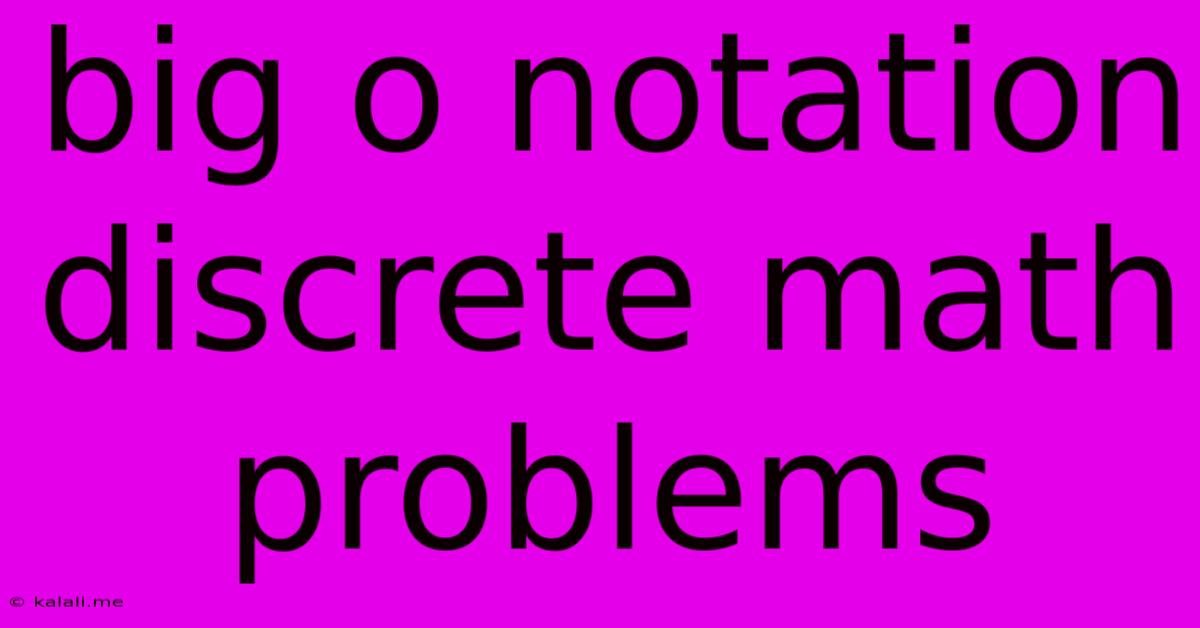Big O Notation Discrete Math Problems
Kalali
Jun 06, 2025 · 4 min read

Table of Contents
Demystifying Big O Notation: Solving Discrete Math Problems with Asymptotic Analysis
Big O notation is a crucial concept in discrete mathematics and computer science, providing a powerful way to analyze the efficiency of algorithms. Understanding Big O allows you to compare different algorithms and predict their performance as the input size grows. This article delves into the core principles of Big O notation and illustrates its application in solving discrete math problems. We'll explore common complexities like O(1), O(log n), O(n), O(n log n), O(n²), and O(2ⁿ), and how they relate to algorithm design.
What is Big O Notation?
Big O notation describes the upper bound of an algorithm's runtime or space complexity. It focuses on how the runtime or space requirements scale with the input size (typically represented by 'n'). We ignore constant factors and lower-order terms because, as 'n' becomes large, their impact diminishes. For instance, an algorithm with a runtime of 5n² + 10n + 5 is considered O(n²) because the n² term dominates as n grows. This simplification allows for a clear comparison of algorithm efficiency.
Key Takeaways:
- Focuses on growth rate: Big O doesn't measure the exact runtime, but rather how the runtime grows relative to the input size.
- Asymptotic analysis: It's concerned with the behavior of algorithms as the input size approaches infinity.
- Upper bound: Big O provides an upper limit on the runtime; the actual runtime could be better, but it won't be worse than the Big O notation suggests.
Common Big O complexities and examples:
Let's examine some frequently encountered Big O complexities:
-
O(1) - Constant Time: The runtime remains constant regardless of the input size. Example: Accessing an element in an array using its index.
-
O(log n) - Logarithmic Time: The runtime increases logarithmically with the input size. This is common in algorithms that repeatedly divide the problem size in half, such as binary search.
-
O(n) - Linear Time: The runtime increases linearly with the input size. Example: Searching for an element in an unsorted array.
-
O(n log n) - Linearithmic Time: A common complexity for efficient sorting algorithms like merge sort and heapsort.
-
O(n²) - Quadratic Time: The runtime increases proportionally to the square of the input size. This often arises in algorithms with nested loops iterating over the entire input. Example: Bubble sort.
-
O(2ⁿ) - Exponential Time: The runtime doubles with each addition to the input size. This indicates an extremely inefficient algorithm for large inputs, often associated with brute-force approaches to problems. Example: Finding all subsets of a set.
Solving Discrete Math Problems using Big O Analysis:
Consider the problem of finding the largest element in an unsorted array:
-
Naive Approach: Iterating through the array and comparing each element with the current maximum. This takes O(n) time because we need to examine each element once.
-
Improved Approach (Doesn't exist): There's no significantly faster way to find the largest element in an unsorted array without examining each element. Therefore, O(n) is the best we can achieve.
Now let's consider sorting algorithms:
-
Bubble Sort: This has a time complexity of O(n²). For large datasets, this becomes very slow.
-
Merge Sort: This algorithm boasts a time complexity of O(n log n), making it significantly more efficient than bubble sort for larger datasets.
Analyzing Recursion with Big O Notation:
Analyzing recursive algorithms often requires the use of the Master Theorem or recursion trees. These tools help determine the overall time complexity by breaking down the recursive calls.
For example, a recursive function that divides the problem into two halves and then recursively processes each half would likely have a time complexity of O(n log n), similar to merge sort.
Conclusion:
Big O notation is an essential tool for analyzing the efficiency of algorithms. By understanding different complexity classes, you can make informed decisions about algorithm selection and optimize your code for performance. Practicing analyzing the time and space complexity of various algorithms and data structures will solidify your understanding and improve your problem-solving skills in discrete mathematics and computer science. Remember, focusing on the dominant terms and the asymptotic behavior as input size grows is key to mastering Big O notation.
Latest Posts
Latest Posts
-
Who Was On The Cross With Jesus
Jun 07, 2025
-
Looks Like Meats Back On The Menu Boys
Jun 07, 2025
-
Car Making Squeaking Noise When Driving
Jun 07, 2025
-
Difference Between Red Lagar And Red Ale
Jun 07, 2025
-
Fallout 4 Melee Instead Of Throw Grenade
Jun 07, 2025
Related Post
Thank you for visiting our website which covers about Big O Notation Discrete Math Problems . We hope the information provided has been useful to you. Feel free to contact us if you have any questions or need further assistance. See you next time and don't miss to bookmark.